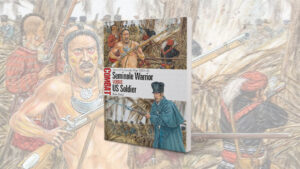As buffalo hides disappeared, ledgers became their medium.
In the latter half of the 19th century two developing realities changed how the Plains Indians recorded their history and culture. First and foremost, these Indians—Lakotas, Cheyennes, Arapahos, Comanches, Kiowas and others— found themselves in escalating conflict with the U.S. government. The inevitable outcome was forced settlement onto reservations or, in some cases, imprisonment. These tribes had traditionally recorded notable events and individual feats on buffalo hides, but the herds had been hunted almost to extinction, and their hides became increasingly unavailable for recording such milestones.
The forced resettlements and loss of buffalo hides were seemingly unrelated, but they shared a notable and lasting consequence: Lacking hides, the confined Indians instead recorded their exploits on the pages of discarded ledger books, while store-bought colored pencils, crayons and inks replaced the mineral and plant pigments found on the prairies. The result was poignant imagery of past battles or other important life events often rendered on top of the white man’s writing.
According to Ross H. Frank, one of the foremost ledger art experts in the United States and an associate professor in the ethnic studies department at the University of California, San Diego, Indian agents, soldiers and other whites interacting with the tribes readily appreciated such art and would purchase or trade goods for a good ledger piece. Artists also gave their ledger illustrations as gifts. Frank is the founder of the Plains Indian Ledger Art Project [plains ledgerart.org], which digitally records ledger art created between 1850 and 1900, then makes it freely accessible online. As the ledger books are spread throughout museums and private collections and are often very fragile, Frank’s digital archive serves as an invaluable asset for researchers, historians and art aficionados.
“The images in the books link so much together in one place,” Frank says. “Often a ledger has been done by a singular person, so they are a general history of an individual. However, in a broader sense they are also ethnographically important in dealing with a scientific description of the Native American culture.” Frank points out that the ledgers often portray battles, such as the June 1876 clash at the Little Bighorn (known by the Lakota as the Greasy Grass), from the Indian perspective. Thus when compared to written accounts of the same battles penned by soldiers, they are especially useful historical sources. And while many museums hold artifacts relevant to the Indian cultures, the ledgers depict such items in use as recalled by the artist.
Frank estimates that more than 200 books of Indian ledger art survive in institutional and private collections. Newly discovered books turn up intermittently, having been passed down from one generation to the next and saved as curios. Others have been disassembled and sold page by page. The oldest known example, a Southern Cheyenne book known as the Bowstring Warrior Society Ledger, dates from the 1850s. Cheyennes under Chief Black Kettle had presented it to a 7-year-old white boy, Ambrose Asher, in September 1864. Weeks earlier Cheyenne Dog Soldiers had killed most members of Asher’s Nebraska Territory homesteading family, taking the boy and several other children captive. Black Kettle ransomed the boy and arranged for his return through Major Edward W. “Ned” Wynkoop, commander of Fort Lyon, Colorado Territory.
Elizabeth Guheen, director and chief curator of the Bair Family Museum [www.bairfamilymuseum.org] in Martinsdale, Mont., considers ledger art the Plains Indian equivalent of written words. “It is a first-person narrative,” she says. “There is no question of authenticity. Nothing gets this close to the life they were living. Ledger art is timeless. When you realize it is so close to the hearts and minds of the people who did it, the events depicted still feel like they just happened. The feeling you get looking at the pieces is so multifaceted, modern technology becomes meaningless.”
The best-known ledger artists came from a group of Plains Indians imprisoned at Fort Marion, in Saint Augustine, Fla., between 1875 and 1878 for their participation in the 1874 Red River War in Indian Territory (present-day Oklahoma). Encouraged to draw by their military overseer, Lieutenant Richard Henry Pratt (who later founded the Carlisle Indian Industrial School in Pennsylvania), 26 of the 72 prisoners, mostly Cheyennes and Kiowas, produced hundreds of drawings and books detailing their former lives as hunters and warriors and new lives as prisoners and students.
Janet Cantley, curator and manager of the Heard Museum North Scottsdale [www.heard.org/north] in Arizona, notes that ledger art experienced a resurgence in the 1970s, as contemporary Indian artists established themselves in the field. Historically the genre was the purview of male artists, but leading the revival were two women, Sharron Ahtone Harjo (Kiowa) and Virginia Stroud (Cherokee/ Creek). Today the genre is almost evenly represented by male and female artists.
Monte Yellow Bird Sr. (aka Black Pinto Horse), an Arikara/Hidatsa artist from Wilsall, Mont. [www.blackpintohorse finearts.com], renders his works on antique ledger sheets, maps and receipts and feels a connection with earlier ledger artists. “I still have the same values of protecting the family and being respectful of the spirits,” he says. “Just like them I want to leave something behind that helps educate the public about the characteristics of my tribe.” Yellow Bird says one aspect overlooked by most scholars is that ledger art was empowering to the Indians. “It was a dark time in our history and a time of real change,” he says. “We are taught there is a spirit attached to the art, and drawing on top of the white man’s words at that time was a positive spirit.”
This year Cantley is curating a ledger art exhibit at the Phoenix campus of the Heard. “Stories Outside the Lines: American Indian Ledger Art” features 30 original pieces of ledger art, 20 contemporary pieces of ledger art, one hide painting and other Plains Indian objects. It runs until September 21.
Originally published in the June 2014 issue of Wild West. To subscribe, click here.




